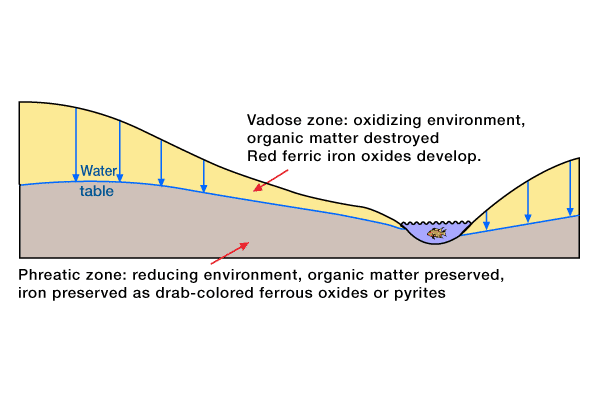Rules of Thumb and Their Limitations
Usually, there are no quick and easy methods that distinguish nonmarine from marine rocks. A few general rules of thumb should be mentioned, however.
In the sedimentary record, many non-marine rocks are associated closely with unconformities, often lying immediately over, or being sandwiched between, major erosional surfaces. Sediments deposited above the water table have their pores filled with air and intermittently percolating groundwater, which is acidic and oxidizing. (Figure 1, Sketch showing relationship between local water table and oxidation. Iron-bearing sediments within the vadose zone have a much higher chance of taking on red coloration.)

They are, therefore, often orange or reddish in color, due to the presence of oxidized (ferric) iron. Below the water table, however, pores are saturated with water that is often stagnant and reducing. Consequently, iron tends to occur as a sulfide (pyrite) or, more commonly, in the drab gray-green ferrous state. Thus, upland eolian, alluvial fan, and braided stream deposits are often reddish in color, while lowland flood plain and lacustrine sediments more closely resemble the drab color of most marine rocks.
Due to lateral lithologic variations in many nonmarine facies, seismic profiles through these rocks are sometimes characterized by discontinuous reflections. (Figure 2, Seismic section to illustrate the discontinuous reflectors which often characterize nonmarine deposits.

Part a is a close-up of the type of reflections commonly seen. Part b is a seismic profile of a preserved river channel. Note discontinuity of reflections within the channel.) This, however, is a generalization and often not the case for nonmarine sequences that represent considerable portions of geologic time. Moreover, lacustrine sediments provide a conspicuous and important exception.
Other potential indicators are nonmarine fossils (e.g., vertebrates, freshwater mollusks and gastropods, insect tracts, rootlet horizons) and exposed-surface sedimentary structures such as raindrop imprints and mudcracks. Nearly all these may occur in transitional marine (e.g., deltaic) environments as well, how-ever. In addition, these types of evidence are all distinctly rare in outcrops, and therefore extremely so in cores.
As a whole, therefore, even in combination, these nonmarine indicators are suspect. In fact, none of them may be present in a section which is determined by detailed analysis to be terrestrial. At the same time, their presence can be used as guiding evidence to tip-off the geologist to the possibility of a nonmarine facies.
Assessment about Nonmarine Sandstones
1. Of the five non-marine sandstone environments the four that have yielded the most in petroleum reserves are:
A .alluvial fan, braided stream, meandering stream, and eolian
B .braided stream, meandering stream, eolian and lacustrine
C .alluvial fan, lacustrine, braided stream, and eolian
2. Non-marine sandstones are generally deposited in an oxidizing environment and may exhibit discontinuous seismic reflections.
A .True
B .False
 Petro Shine The Place for Oil and Gas Professionals.
Petro Shine The Place for Oil and Gas Professionals.



